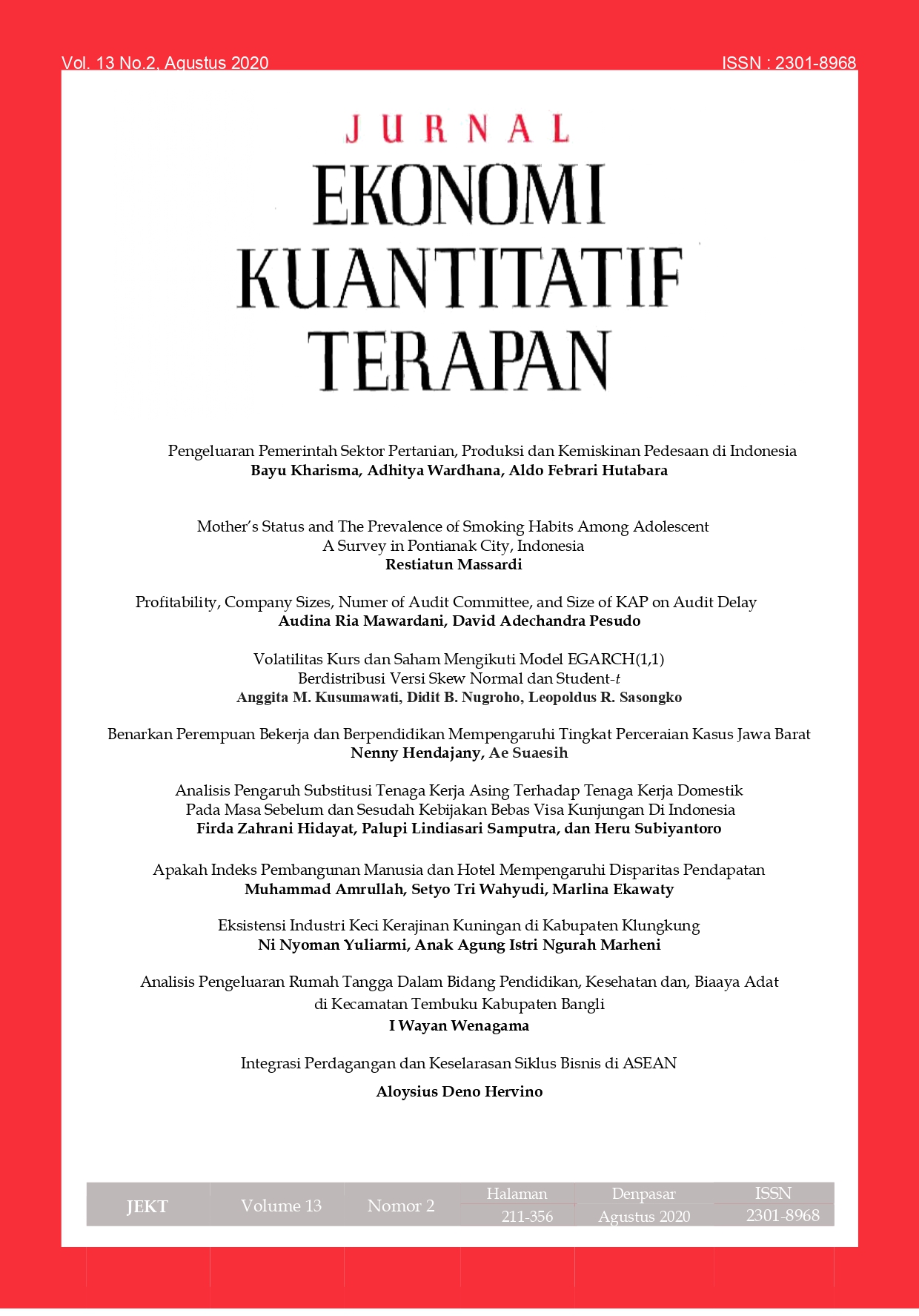Mother’s Status and the Prevalence of Smoking Habits among Adolescents: A Survey in Pontianak City, Indonesia
Abstract
The smoking rate of adolescent continues to increase in Indonesia. It is necessary to involve all parties in the anti-smoking campaign, including mothers.This research aims to find out about the influences of mother’s status on the prevalence of smoking habits among adolescent. Mother’s status in this research referred to education level and occupation status. This research data was obtained from a survey questionnaire with 998 adolescent respondents in Pontianak City, Indonesia. The research findings showed that only mother’s occupation status significantly influences the probability for mothers to give some suggestions to their children about the danger of smoking. However, mother’s suggestion variable did not significantly influence their children’s decision to smoke. But the significant variables to influence adolescents’ decision to smoke were smoking parents and father’s suggestions about the danger of smoking.This is due to the culture of Indonesian society, children tend to more obey their fathers’ advice than their mothers’ ones.
Keywords: Adolescent; Smoking Habit; Mother’s status, Education level, Occupation status.
Downloads
References
Australian Institute of Health and Welfare (2010), Australia’s Health 2010, Australia’s Health Series, 12, AIHW, Canberra.
Australian Institute of Health and Welfare (2012), Australia’s Health 2012, Australia’s Health Series, 13, AIHW, Canberra.
Barsky, Robert B., F. Thomas Juster, Miles S. Kimball dan Matthew D. Saphiro. (1997). Preference Parameters and Behavioral Heterogeneity: An Experimental Approach in The Health and Retirement Study. The Quarterly Journal of Economics, Vol.112 No.2, May, 537-579.
Boujikian, Danielle S. (2015). Targeting the “Pre - Smokers”: A Review of Three Factors Assosiated with Adolescent Smoking Habits. A PROJECT REPORT. Loyola Marymount University.
Breslau, N. and Peterson, E.L. (1996). Smoking cessation in young adults: age at initiation of cigarette smoking and other suspected influences. American Journal of Public Health, Vol.86 No.2, 214-220.
Decima Research. (1991). Pepsi/YTV Street Beat: a teen poll. A nationwide survey of Canadian teens. Toronto, Canada: Decima Research.
Glendinning A. (2002). Self-esteem and smoking in youth-muddying the waters? Adolescence, 25(4), 415-425.
Greaves L. (1987). Background paper on women and tobacco. Ottawa, Canada: Health and Welfare Canada, Health Promotion Directorate.
Siti Rabaah Hamzah, TurimanSuandi, Maimunah Ismail & Zulaiha Muda (2019) Association of the personal factors of culture, attitude and motivation with health behavior among adolescents in Malaysia. International Journal of Adolescence and Youth, 24:2, 149-159, DOI: 10.1080/02673843.2018.1482772
Hertel, A.W., and Mermelstein, R.J. (2012). Smoker identity and smoking escalation among adolescents. Health Psychology, 31(4), 467-475. DOI: 10.1037/a0028923
Hesket T, Qu D, Tomkins A. (2001). Smoking among youth in China. American Journal Public Health, 91, 1653-1659.
Husten, C.G. (2007). Smoking cessation in young adults. American Journal of Public Health, Vol. 97 No. 8, 1354-1356.
Jamaliah and Massardi, R. (2017). The Influence of School Type on the Initial Smoking Age among Adolescents: A Survey in Pontianak City, West Kalimantan, Indonesia”. Asian Journal of Social Science Studies,Vol 2(4), 2017, 54-60 http://journal.julypress.com/index.php/ajsss/issue/view/23
John, D.R. (1999). Consumer socialization of children: a retrospective look at twenty-five years of research. Journal of Consumer Research, Vol. 26 No. 3, 183-213.
Lieb, R., Schreier, A., Pfister, H., and Wittchen, H. U. (2003). Maternal smoking and smoking in adolescents: a prospective community study of adolescents and their mothers. European Addiction Research, 9(3), 120-130.
Loureiro, Sanz-de-Galdeano, &Vuri. (2006). Smoking Habits: Like Father, Like Son, Like Mother, Like Daughter. IZA Discussion Paper No. 2279, August.
Mahabee-Gittens, E.M., Xiao, Y., Gordon, J.S., &Khoury, J.C. (2012). Continued importance of family factors in youth smoking behavior. Nicotine & Tobacco Research, 14(12), 1458-1466. https://doi.org/10.1093/ntr/nts078
Messer, K., Trinidad, D.R.P., Al-Delaimy, W.K.M.D.P. and Pierce, J.P.P. (2008). Smoking cessation rates in the United States: a comparison of young adult and older smokers. American Journal of Public Health, Vol. 98 No. 2, 317-322.
Millar WJ. (1985). Smoking prevalence among Canadian adolescents: a comparison of survey estimates. Canada Journal of Public Health, 5, 76, 33–7.
Nixon, John and Philippe Ulmann. (2006). The Relationship between Health Care Expenditure and Health Outcomes: Evidence and Caveats for a Causal Link. The European Journal of Health Economics, Vol.7 No.1, March, 7-18.
Pederson LL, Koval J, McGrady G, Tyas SL. (1998). The degree and type of relationship between psychosocial variables and smoking status for students in grade 8: Is there a dose-response relationship? Prev Med; 27(3), 337-347.
Suwanteerangkul J. (2000). Factors Associated with smoking of adolescent in Chiangmai. Chiang Mai Medical Bulletin; 31, 19-29.
Statistics Canada. Health status of Canadians: report of the 1991 General Social Survey. Ottawa, Canada: Ministry of Industry, Science and Technology. (1994). (Catalogue No 11-612E, No 8.)
Statistics Canada. Survey on smoking in Canada, cycle 1 through cycle 4. (1995). Ottawa, Canada: Special Surveys Division, June.
Samet, JM and Yoon, SY. (2001). Women and the tobacco epidemic: challenges for the 21st Century. J Sch Health, 73, 207-214. (Cited in Global Youth Tobacco Survey Collaborating Group. Differences in worldwide tobacco use by gender: Finding from the Youth Tobacco Survey).
The Jakarta Post, edition on 11 July 2018. http://thejakartapost.com/academia/2018/07/11/controlling-tobacco-case-of-children-human-right.html
Wild, Lauren G., Flishe Alan J., Bhana Arvin and Lombard Carl. (2004). Associations among adolescent risk behaviors and self-esteem in six domains. JCPP, 45(8), 1454.
Witte, K. (1992). Putting the fear back into fear appeals: the extended parallel process model. Communication Monographs, Vol. 59, December, 329-349.




















